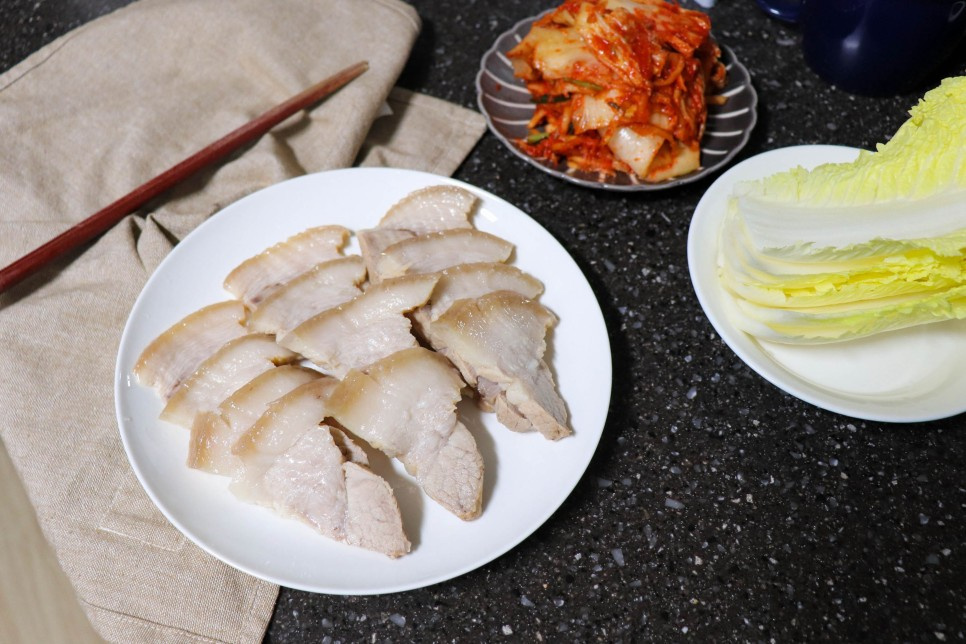Tender and Delicious Boiled Pork (Suyuk) – The Ultimate Recipe
Kimchi Seasoning Special! How to Perfectly Boil Tender and Moist Pork Belly (Suyuk)

No Kimchi season is complete without delicious Suyuk! We’re sharing the secret to making pork that’s free of gamey odors, incredibly moist, and melt-in-your-mouth tender, just like the kind you get at restaurants. It’s perfect when enjoyed with a whole pork belly cut and crisp napa cabbage. Get ready to make your own incredibly tender Suyuk at home!
Main Ingredients- Pork Belly or Shoulder 1 piece (approx. 600g-1kg)
- Onion 1/2
- Green Onion 1 stalk
- Whole Peppercorns, a pinch
- Cheongju (rice wine) or Soju 1/2 cup
- Bay Leaves 2-3
- Doenjang (fermented soybean paste) 1 Tbsp
- Instant Coffee 1/2 Tbsp (optional)
Cooking Instructions
Step 1
First, rinse the pork belly or shoulder piece thoroughly. Place it in a pot and add enough cold water to cover the meat. If the piece is very large, cut it into 2-3 portions before adding it to the pot. Pre-cutting helps ensure even cooking.

Step 2
Now, let’s add the aromatics to get rid of any porky smell. Add the halved onion, roughly chopped green onion, a pinch of whole peppercorns, and 1/2 cup of Cheongju or Soju to the pot. Alcohol effectively helps to remove any unpleasant odors from the meat.

Step 3
Here’s a secret weapon for tenderizing and flavor: add 1 tablespoon of Doenjang (fermented soybean paste). Doenjang not only adds a savory depth but also helps to tenderize the meat. (While optional, adding Doenjang significantly enhances the flavor!) If you have instant coffee, add about 1/2 tablespoon. Coffee helps to remove any remaining bloodiness and improves the color of the meat; don’t worry, it won’t make the pork taste like coffee. Adding 2-3 bay leaves will also contribute a lovely aroma.

Step 4
Now, cover the pot and bring it to a boil over medium heat. Once boiling, reduce the heat to medium-low and let it simmer gently for about 50 minutes to 1 hour, depending on the thickness of the meat. Simmering covered over low heat is key to tenderizing the pork. The longer it simmers, the more tender it will become.

Step 5
Wondering how to check if the pork is cooked through? It’s simple. Insert a chopstick into the thickest part of the meat. If clear juices run out, it’s not quite done yet, so continue simmering until no pinkness is visible. If the chopstick goes in smoothly and only clear liquid comes out, it’s perfectly cooked.

Step 6
After simmering for about 50 minutes, I checked the pork, and it was perfectly cooked – no pink juices when poked with a chopstick! Using tongs, carefully remove the pork from the pot. Be cautious as it will be hot.

Step 7
It’s best to let the pork cool slightly before slicing, rather than slicing it while piping hot. This helps prevent it from falling apart and results in cleaner slices. Slice it to your desired thickness. This time, I sliced it a bit thinner than usual, and it was wonderfully satisfying – savory with every bite and incredibly tender! It’s absolutely divine when served as a wrap with fresh kimchi or a crisp napa cabbage salad.




